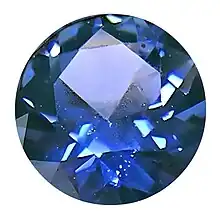Sapphire
Sapphire is a precious gemstone, a variety of the mineral corundum, consisting of aluminium oxide (α-Al2O3) with trace amounts of elements such as iron, titanium, cobalt, lead, chromium, vanadium, magnesium, boron, and silicon. The name sapphire is derived via the Latin sapphirus from the Greek sappheiros (σάπφειρος), which referred to lapis lazuli.[2] It is typically blue, but natural "fancy" sapphires also occur in yellow, purple, orange, and green colors; "parti sapphires" show two or more colors. Red corundum stones also occur, but are called rubies rather than sapphires.[3] Pink-colored corundum may be classified either as ruby or sapphire depending on locale. Commonly, natural sapphires are cut and polished into gemstones and worn in jewelry. They also may be created synthetically in laboratories for industrial or decorative purposes in large crystal boules. Because of the remarkable hardness of sapphires – 9 on the Mohs scale (the third hardest mineral, after diamond at 10 and moissanite at 9.5) – sapphires are also used in some non-ornamental applications, such as infrared optical components, high-durability windows, wristwatch crystals and movement bearings, and very thin electronic wafers, which are used as the insulating substrates of special-purpose solid-state electronics such as integrated circuits and GaN-based blue LEDs. Sapphire is the birthstone for September and the gem of the 45th anniversary. A sapphire jubilee occurs after 65 years.[4]
| Sapphire | |
|---|---|
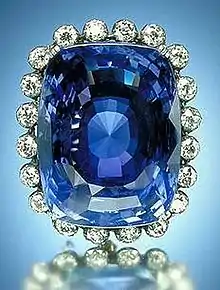 The 423-carat (85 g) blue Logan Sapphire | |
| General | |
| Category | Oxide mineral |
| Formula (repeating unit) | Aluminium oxide, Al2O3 |
| Crystal system | Trigonal |
| Crystal class | Hexagonal scalenohedral (3m) H-M symbol: (32/m) |
| Space group | R3c |
| Identification | |
| Color | Typically blue, but varies |
| Crystal habit | As crystals, massive and granular |
| Twinning | Both growth twins (in various orientations) and polysynthetic glide twinning on the rhombohedron [1011 |
| Cleavage | Poor |
| Fracture | Conchoidal, splintery |
| Mohs scale hardness | 9.0 |
| Luster | Vitreous |
| Streak | Colorless |
| Diaphaneity | Transparent to nearly opaque |
| Specific gravity | 3.98–4.06 |
| Optical properties | Abbe number 72.2 |
| Refractive index | nω = 1.768–1.772 nε = 1.760–1.763, birefringence 0.008 |
| Pleochroism | Strong |
| Melting point | 2,030–2,050 °C |
| Fusibility | Infusible |
| Solubility | Insoluble |
| Other characteristics | Coefficient of thermal expansion (5.0–6.6)×10−6/K relative permittivity at 20 °C ε = 8.9–11.1 (anisotropic)[1] |
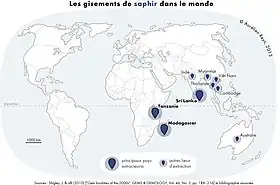
Natural sapphires
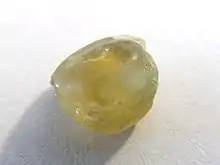
Sapphire is one of the two gem-varieties of corundum, the other being ruby (defined as corundum in a shade of red). Although blue is the best-known sapphire color, they occur in other colors, including gray and black, and also can be colorless. A pinkish orange variety of sapphire is called padparadscha.
Significant sapphire deposits are found in Australia, Afghanistan, Cambodia, Cameroon, China (Shandong), Colombia, Ethiopia, India Jammu and Kashmir(Padder, Kishtwar), Kenya, Laos, Madagascar, Malawi, Mozambique, Myanmar (Burma), Nigeria, Rwanda, Sri Lanka, Tanzania, Thailand, United States (Montana) and Vietnam.[5]: 431–707 Sapphire and rubies are often found in the same geographical settings, but they generally have different geological formations. For example, both ruby and sapphire are found in Myanmar's Mogok Stone Tract, but the rubies form in marble, while the sapphire forms in granitic pegmatites or corundum syenites.[5]: 403–429
Every sapphire mine produces a wide range of quality, and origin is not a guarantee of quality. For sapphire, Jammu and Kashmir receives the highest premium, although Burma, Sri Lanka, and Madagascar also produce large quantities of fine quality gems.[3]
The cost of natural sapphires varies depending on their color, clarity, size, cut, and overall quality. Sapphires that are completely untreated are worth far more than those that have been treated. Geographical origin also has a major impact on price. For most gems of one carat or more, an independent report from a respected laboratory such as GIA, Lotus Gemology, or SSEF, is often required by buyers before they will make a purchase.[6]
Colors
Sapphires in colors other than blue are called "fancy" or "parti-colored" sapphires.[7]
Fancy sapphires are often found in yellow, orange, green, brown, purple and violet hues.[8]
Blue sapphire
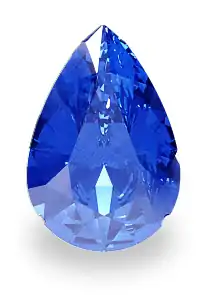
Gemstone color can be described in terms of hue, saturation, and tone. Hue is commonly understood as the "color" of the gemstone. Saturation refers to the vividness or brightness of the hue, and tone is the lightness to darkness of the hue.[5]: 333–401 Blue sapphire exists in various mixtures of its primary (blue) and secondary hues, various tonal levels (shades) and at various levels of saturation (vividness).
Blue sapphires are evaluated based upon the purity of their blue hue. Violet and green are the most common secondary hues found in blue sapphires.[5]: 333–401 The highest prices are paid for gems that are pure blue and of vivid saturation. Gems that are of lower saturation, or are too dark or too light in tone are of less value. However, color preferences are a personal taste, like a flavor of ice cream.[5]: 333–401
The 423-carat (84.6 g) Logan sapphire in the National Museum of Natural History, in Washington, D.C., is one of the largest faceted gem-quality blue sapphires in existence.

The 422.66-ct Siren of Serendip[9] in the Houston Museum of Natural Science is another stunning example of a Sri Lankan sapphire on public display.
Parti sapphires
Particolored sapphires (or bi-color sapphires) are those stones that exhibit two or more colors within a single stone.[8] The desirability of particolored or bi-color sapphires is usually judged based on the zoning or location of their colors, the colors' saturation, and the contrast of their colors.[10] Australia is the largest source of particolored sapphires; they are not commonly used in mainstream jewelry and remain relatively unknown. Particolored sapphires cannot be created synthetically and only occur naturally.[10]
Pink sapphires
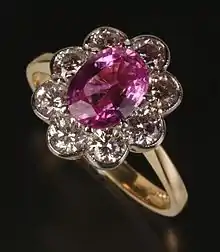
Pink sapphires occur in shades from light to dark pink, and deepen in color as the quantity of chromium increases. The deeper the pink color, the higher their monetary value. In the United States, a minimum color saturation must be met to be called a ruby, otherwise the stone is referred to as a pink sapphire.[11]
Padparadscha
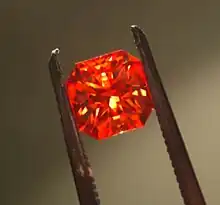
Padparadscha is a delicate, light to medium toned, pink-orange to orange-pink hued corundum, originally found in Sri Lanka,[12] but also found in deposits in Vietnam and parts of East Africa. Padparadscha sapphires are rare; the rarest of all is the totally natural variety, with no sign of artificial treatment.[13]
The name is derived from the Sanskrit padma ranga (padma = lotus; ranga = color), a color akin to the lotus flower (Nelumbo nucifera).[14]
Among the fancy (non-blue) sapphires, natural padparadscha fetch the highest prices. Since 2001, more sapphires of this color have appeared on the market as a result of artificial lattice diffusion of beryllium.[15]
Star sapphire

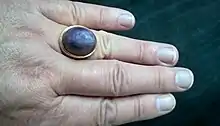
A star sapphire is a type of sapphire that exhibits a star-like phenomenon known as asterism; red stones are known as "star rubies". Star sapphires contain intersecting needle-like inclusions following the underlying crystal structure that causes the appearance of a six-rayed "star"-shaped pattern when viewed with a single overhead light source. The inclusion is often the mineral rutile, a mineral composed primarily of titanium dioxide.[16] The stones are cut en cabochon, typically with the center of the star near the top of the dome. Occasionally, twelve-rayed stars are found, typically because two different sets of inclusions are found within the same stone, such as a combination of fine needles of rutile with small platelets of hematite; the first results in a whitish star and the second results in a golden-colored star. During crystallization, the two types of inclusions become preferentially oriented in different directions within the crystal, thereby forming two six-rayed stars that are superimposed upon each other to form a twelve-rayed star.[17] Misshapen stars or 12-rayed stars may also form as a result of twinning. The inclusions can alternatively produce a cat's eye effect if the girdle plane of the cabochon is oriented parallel to the crystal's c-axis rather than perpendicular to it. To get a cat's eye, the planes of exsolved inclusions must be extremely uniform and tightly packed. If the dome is oriented in between these two directions, an off-center star will be visible, offset away from the high point of the dome.[5]: 101
At 1404.49 carats, The Star of Adam is the largest known blue star sapphire. The gem was mined in the city of Ratnapura, southern Sri Lanka.[18] The Black Star of Queensland, the second largest star sapphire in the world, weighs 733 carats.[19] The Star of India mined in Sri Lanka and weighing 563.4 carats is thought to be the third-largest star sapphire, and is currently on display at the American Museum of Natural History in New York City. The 182-carat Star of Bombay, mined in Sri Lanka and located in the National Museum of Natural History in Washington, D.C., is another example of a large blue star sapphire. The value of a star sapphire depends not only on the weight of the stone, but also the body color, visibility, and intensity of the asterism. The color of the stone has more impact on the value than the visibility of the star. Since more transparent stones tend to have better colors, the most expensive star stones are semi-transparent "glass body" stones with vivid colors.[5]: 348–350
On 28 July 2021, the world's largest cluster of star sapphires, weighing 510 kg, was unearthed from Ratnapura, Sri Lanka. This star sapphire cluster was named "Serendipity Sapphire".[20][21]
Color-change sapphire
A rare variety of natural sapphire, known as color-change sapphire, exhibits different colors in different light. Color change sapphires are blue in outdoor light and purple under incandescent indoor light, or green to gray-green in daylight and pink to reddish-violet in incandescent light. Color-change sapphires come from a variety of locations, including Madagascar, Myanmar, Sri Lanka and Tanzania. Two types exist. The first features the chromium chromophore that creates the red color of ruby, combined with the iron + titanium chromophore that produces the blue color in sapphire. A rarer type, which comes from the Mogok area of Myanmar, features a vanadium chromophore, the same as is used in Verneuil synthetic color-change sapphire.
Virtually all gemstones that show the "alexandrite effect" (color change; a.k.a. 'metamerism') show similar absorption/transmission features in the visible spectrum. This is an absorption band in the yellow (~590 nm), along with valleys of transmission in the blue-green and red. Thus the color one sees depends on the spectral composition of the light source. Daylight is relatively balanced in its spectral power distribution (SPD) and since the human eye is most sensitive to green light, the balance is tipped to the green side. However incandescent light (including candle light) is heavily tilted to the red end of the spectrum, thus tipping the balance to red.[22]
Color-change sapphires colored by the Cr + Fe/Ti chromophores generally change from blue or violet-blue to violet or purple. Those colored by the V chromophore can show a more pronounced change, moving from blue-green to purple.
Certain synthetic color-change sapphires have a similar color change to the natural gemstone alexandrite and they are sometimes marketed as "alexandrium" or "synthetic alexandrite". However, the latter term is a misnomer: synthetic color-change sapphires are, technically, not synthetic alexandrites but rather alexandrite simulants. This is because genuine alexandrite is a variety of chrysoberyl: not sapphire, but an entirely different mineral.[23]
Large rubies and sapphires
Large rubies and sapphires of poor transparency are frequently used with suspect appraisals that vastly overstate their value. This was the case of the "Life and Pride of America Star Sapphire". Circa 1985, Roy Whetstine claimed to have bought the 1905-ct stone for $10 at the Tucson gem show, but a reporter discovered that L.A. Ward of Fallbrook, CA, who appraised it at the price of $1200/ct, had appraised another stone of the exact same weight several years before Whetstine claimed to have found it.[24]
Bangkok-based Lotus Gemology maintains an updated listing of world auction records of ruby, sapphire, and spinel. As of November 2019, no sapphire has ever sold at auction for more than $17,295,796.[25]
Cause of color
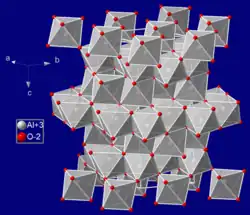
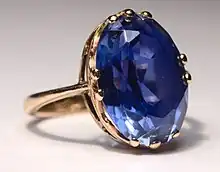
Rubies are corundum with a dominant red body color. This is generally caused by traces of chromium (Cr3+) substituting for the (Al3+) ion in the corundum structure. The color can be modified by both iron and trapped hole color centers.[26]
Unlike localized ("intra-atomic") absorption of light, which causes color for chromium and vanadium impurities, blue color in sapphires comes from intervalence charge transfer, which is the transfer of an electron from one transition-metal ion to another via the conduction or valence band. The iron can take the form Fe2+ or Fe3+, while titanium generally takes the form Ti4+. If Fe2+ and Ti4+ ions are substituted for Al3+, localized areas of charge imbalance are created. An electron transfer from Fe2+ and Ti4+ can cause a change in the valence state of both. Because of the valence change, there is a specific change in energy for the electron, and electromagnetic energy is absorbed. The wavelength of the energy absorbed corresponds to yellow light. When this light is subtracted from incident white light, the complementary color blue results. Sometimes when atomic spacing is different in different directions, there is resulting blue-green dichroism.
Purple sapphires contain trace amounts of chromium and iron plus titanium and come in a variety of shades. Corundum that contains extremely low levels of chromophores is near colorless. Completely colorless corundum generally does not exist in nature. If trace amounts of iron are present, a very pale yellow to green color may be seen. However, if both titanium and iron impurities are present together, and in the correct valence states, the result is a blue color.[27]
Intervalence charge transfer is a process that produces a strong colored appearance at a low percentage of impurity. While at least 1% chromium must be present in corundum before the deep red ruby color is seen, sapphire blue is apparent with the presence of only 0.01% of titanium and iron.
Colorless sapphires, which are uncommon in nature, were once used as diamond substitutes in jewelry, and are presently used as accent stones.[8]
The most complete description of the causes of color in corundum extant can be found in Chapter 4 of Ruby & Sapphire: A Gemologist's Guide (chapter authored by John Emmett, Emily Dubinsky and Richard Hughes).[5]: 107–164
Treatments
Sapphires can be treated by several methods to enhance and improve their clarity and color.[5]: 197–247 It is common practice to heat natural sapphires to improve or enhance their appearance. This is done by heating the sapphires in furnaces to temperatures between 800 and 1,800 °C (1,470 and 3,270 °F) for several hours, or even weeks at a time. Different atmospheres may be used. Upon heating, the stone becomes bluer in color, but loses some of the rutile inclusions (silk). When high temperatures (1400 °C+) are used, exsolved rutile silk is dissolved and it becomes clear under magnification. The titanium from the rutile enters solid solution and thus creates with iron the blue color [28] The inclusions in natural stones are easily seen with a jeweler's loupe. Evidence of sapphire and other gemstones being subjected to heating goes back at least to Roman times.[29] Un-heated natural stones are somewhat rare and will often be sold accompanied by a certificate from an independent gemological laboratory attesting to "no evidence of heat treatment".
Yogo sapphires do not need heat treating because their cornflower blue color is attractive out of the ground; they are generally free of inclusions, and have high uniform clarity.[30] When Intergem Limited began marketing the Yogo in the 1980s as the world's only guaranteed untreated sapphire, heat treatment was not commonly disclosed; by the late 1980s, heat treatment became a major issue.[31] At that time, much of all the world's sapphires were being heated to enhance their natural color.[32] Intergem's marketing of guaranteed untreated Yogos set them against many in the gem industry. This issue appeared as a front-page story in The Wall Street Journal on 29 August 1984 in an article by Bill Richards, Carats and Schticks: Sapphire Marketer Upsets The Gem Industry.[32] However, the biggest problem the Yogo mine faced was not competition from heated sapphires, but the fact that the Yogo stones could never produce quantities of sapphire above one carat after faceting. As a result, it has remained a niche product, with a market that largely exists in the US.[5]: 676–695
Lattice ('bulk') diffusion treatments are used to add impurities to the sapphire to enhance color. This process was originally developed and patented by Linde Air division of Union Carbide and involved diffusing titanium into synthetic sapphire to even out the blue color.[33] It was later applied to natural sapphire. Today, titanium diffusion often uses a synthetic colorless sapphire base. The color layer created by titanium diffusion is extremely thin (less than 0.5 mm). Thus repolishing can and does produce slight to significant loss of color. Chromium diffusion has been attempted, but was abandoned due to the slow diffusion rates of chromium in corundum.
In the year 2000, beryllium diffused "padparadscha" colored sapphires entered the market. Typically beryllium is diffused into a sapphire under very high heat, just below the melting point of the sapphire. Initially (c. 2000) orange sapphires were created, although now the process has been advanced and many colors of sapphire are often treated with beryllium. Due to the small size of the beryllium ion, the color penetration is far greater than with titanium diffusion. In some cases, it may penetrate the entire stone. Beryllium-diffused orange sapphires may be difficult to detect, requiring advanced chemical analysis by gemological labs (e.g., Gübelin, SSEF, GIA, American Gemological Laboratories (AGL), Lotus Gemology.[6]
According to United States Federal Trade Commission guidelines, disclosure is required of any mode of enhancement that has a significant effect on the gem's value.[34]
There are several ways of treating sapphire. Heat-treatment in a reducing or oxidizing atmosphere (but without the use of any other added impurities) is commonly used to improve the color of sapphires, and this process is sometimes known as "heating only" in the gem trade. In contrast, however, heat treatment combined with the deliberate addition of certain specific impurities (e.g. beryllium, titanium, iron, chromium or nickel, which are absorbed into the crystal structure of the sapphire) is also commonly performed, and this process can be known as "diffusion" in the gem trade. However, despite what the terms "heating only" and "diffusion" might suggest, both of these categories of treatment actually involve diffusion processes.[35]
The most complete description of corundum treatments extant can be found in Chapter 6 of Ruby & Sapphire: A Gemologist's Guide (chapter authored by John Emmett, Richard Hughes and Troy R. Douthit).[5]: 197–247
Mining
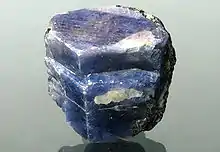
Sapphires are mined from alluvial deposits or from primary underground workings. Commercial mining locations for sapphire and ruby include (but are not limited to) the following countries: Afghanistan, Australia, Myanmar/Burma, Cambodia, China, Colombia, India, Kenya, Laos, Madagascar, Malawi, Nepal, Nigeria, Pakistan, Sri Lanka, Tajikistan, Tanzania, Thailand, United States, and Vietnam. Sapphires from different geographic locations may have different appearances or chemical-impurity concentrations, and tend to contain different types of microscopic inclusions. Because of this, sapphires can be divided into three broad categories: classic metamorphic, non-classic metamorphic or magmatic, and classic magmatic.[36]
Sapphires from certain locations, or of certain categories, may be more commercially appealing than others,[37] particularly classic metamorphic sapphires from Kashmir, Burma, or Sri Lanka that have not been subjected to heat-treatment.[38][39]
The Logan sapphire, the Star of India, The Star of Adam and the Star of Bombay originate from Sri Lankan mines. Madagascar is the world leader in sapphire production (as of 2007) specifically its deposits in and around the town of Ilakaka.[40] Prior to the opening of the Ilakaka mines, Australia was the largest producer of sapphires (such as in 1987).[41] In 1991 a new source of sapphires was discovered in Andranondambo, southern Madagascar. That area has been exploited for its sapphires started in 1993, but it was practically abandoned just a few years later—because of the difficulties in recovering sapphires in their bedrock.[42]
In North America, sapphires have been mined mostly from deposits in Montana: facies along the Missouri River near Helena, Montana, Dry Cottonwood Creek near Deer Lodge, Montana, and Rock Creek near Philipsburg, Montana. Fine blue Yogo sapphires are found at Yogo Gulch west of Lewistown, Montana.[31] A few gem-grade sapphires and rubies have also been found in the area of Franklin, North Carolina.[43]
The sapphire deposits of Kashmir are well known in the gem industry, although their peak production took place in a relatively short period at the end of the nineteenth and early twentieth centuries.[5]: 463–482 These deposits are located in the Paddar Valley of the Jammu region of Jammu and Kashmir in India.[44] They have a superior vivid blue hue, coupled with a mysterious and almost sleepy quality, described by some gem enthusiasts as ‘blue velvet”. Kashmir-origin contributes meaningfully to the value of a sapphire, and most corundum of Kashmir origin can be readily identified by its characteristic silky appearance and exceptional hue.[45][44] The unique blue appears lustrous under any kind of light, unlike non-Kashmir sapphires which may appear purplish or grayish in comparison.[46] Sotheby's has been in the forefront overseeing record-breaking sales of Kashmir sapphires worldwide. In October 2014, Sotheby's Hong Kong achieved consecutive per-carat price records for Kashmir sapphires – first with the 12.00 carat Cartier sapphire ring at US$193,975 per carat, then with a 17.16 carat sapphire at US$236,404, and again in June 2015 when the per-carat auction record was set at US$240,205.[47] At present, the world record price-per-carat for sapphire at auction is held by a sapphire from Kashmir in a ring, which sold in October 2015 for approximately US$242,000 per carat (HK$52,280,000 in total, including buyer's premium, or more than US$6.74 million).[47]
Synthetic sapphire
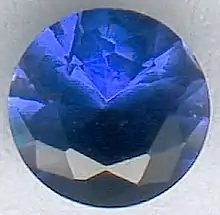
In 1902, the French chemist Auguste Verneuil announced a process for producing synthetic ruby crystals.[48] In the flame-fusion (Verneuil process), fine alumina powder is added to an oxyhydrogen flame, and this is directed downward against a ceramic pedestal.[49] Following the successful synthesis of ruby, Verneuil focussed his efforts on sapphire. Synthesis of blue sapphire came in 1909, after chemical analyses of sapphire suggested to Verneuil that iron and titanium were the cause of the blue color. Verneuil patented the process of producing synthetic blue sapphire in 1911.[50][5]: 254–255
The key to the process is that the alumina powder does not melt as it falls through the flame. Instead it forms a sinter cone on the pedestal. When the tip of that cone reaches the hottest part of the flame, the tip melts. Thus the crystal growth is started from a tiny point, ensuring minimal strain.
Next, more oxygen is added to the flame, causing it to burn slightly hotter. This expands the growing crystal laterally. At the same time, the pedestal is lowered at the same rate that the crystal grows vertically. The alumina in the flame is slowly deposited, creating a teardrop shaped "boule" of sapphire material. This step is continued until the desired size is reached, the flame is shut off and the crystal cools. The now elongated crystal contains a lot of strain due to the high thermal gradient between the flame and surrounding air. To release this strain, the now finger-shaped crystal will be tapped with a chisel to split it into two halves.[5]: 249–309
Due to the vertical layered growth of the crystal and the curved upper growth surface (which starts from a drop), the crystals will display curved growth lines following the top surface of the boule. This is in contrast to natural corundum crystals, which feature angular growth lines expanding from a single point and following the planar crystal faces.[51]
Dopants
Chemical dopants can be added to create artificial versions of the ruby, and all the other natural colors of sapphire, and in addition, other colors never seen in geological samples. Artificial sapphire material is identical to natural sapphire, except it can be made without the flaws that are found in natural stones. The disadvantage of the Verneuil process is that the grown crystals have high internal strains. Many methods of manufacturing sapphire today are variations of the Czochralski process, which was invented in 1916 by Polish chemist Jan Czochralski.[52] In this process, a tiny sapphire seed crystal is dipped into a crucible made of the precious metal iridium or molybdenum,[53] containing molten alumina, and then slowly withdrawn upward at a rate of 1 to 100 mm per hour. The alumina crystallizes on the end, creating long carrot-shaped boules of large size up to 200 kg in mass.[54]
Other growth methods
Synthetic sapphire is also produced industrially from agglomerated aluminum oxide, sintered and fused (such as by hot isostatic pressing) in an inert atmosphere, yielding a transparent but slightly porous polycrystalline product.[55]
In 2003, the world's production of synthetic sapphire was 250 tons (1.25 × 109 carats), mostly by the United States and Russia.[56][57] The availability of cheap synthetic sapphire unlocked many industrial uses for this unique material.
Windows
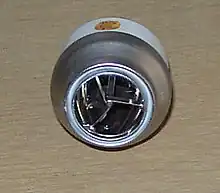
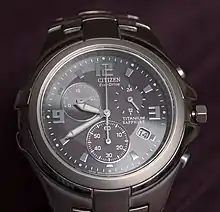
Synthetic sapphire – sometimes referred to as sapphire glass – is commonly used as a window material, because it is both highly transparent to wavelengths of light between 150 nm (UV) and 5500 nm (IR) (the visible spectrum extends about 380 nm to 750 nm[58]), and extraordinarily scratch-resistant.[59][60]
The key benefits of sapphire windows are:
- Very wide optical transmission band from UV to near infrared (0.15–5.5 µm)
- Significantly stronger than other optical materials or standard glass windows
- Highly resistant to scratching and abrasion (9 on the Mohs scale of mineral hardness scale, the 3rd hardest natural substance next to moissanite and diamonds)[45]
- Extremely high melting temperature (2030 °C)

Some sapphire-glass windows are made from pure sapphire boules that have been grown in a specific crystal orientation, typically along the optical axis, the c axis, for minimum birefringence for the application.[61][62]
The boules are sliced up into the desired window thickness and finally polished to the desired surface finish. Sapphire optical windows can be polished to a wide range of surface finishes due to its crystal structure and its hardness. The surface finishes of optical windows are normally called out by the scratch-dig specifications in accordance with the globally adopted MIL-O-13830 specification.
The sapphire windows are used in both high-pressure and vacuum chambers for spectroscopy, crystals in various watches, and windows in grocery-store barcode scanners, since the material's exceptional hardness and toughness makes it very resistant to scratching.[56]
In 2014 Apple consumed "one-fourth of the world’s supply of sapphire to cover the iPhone’s camera lens and fingerprint reader".[63]
Several attempts have been made to make sapphire screens for smartphones viable. Apple contracted GT Advanced Technologies, Inc. to manufacture sapphire screens for iPhones, but the venture failed resulting in the bankruptcy of GTAT.[64] The Kyocera Brigadier was the first production smartphone to feature a sapphire screen.[65]
It is used for end windows on some high-powered laser tubes, as its wide-band transparency and thermal conductivity allow it to handle very high power densities in the infrared and UV spectrum without degrading due to heating.
Along with zirconia and aluminum oxynitride, synthetic sapphire is used for shatter-resistant windows in armored vehicles and various military body armor suits, in association with composites.
One type of xenon arc lamp – originally called the "Cermax" and now known generically as the "ceramic-body xenon lamp" – uses sapphire crystal output windows. This product tolerates higher thermal loads and thus higher output powers when compared with conventional Xe lamps with pure silica window.[66][67]
As substrate for semiconducting circuits
Thin sapphire wafers were the first successful use of an insulating substrate upon which to deposit silicon to make the integrated circuits known as silicon on sapphire or "SOS"; now other substrates can also be used for the class of circuits known more generally as silicon on insulator. Besides its excellent electrical insulating properties, sapphire has high thermal conductivity. CMOS chips on sapphire are especially useful for high-power radio-frequency (RF) applications such as those found in cellular telephones, public-safety band radios, and satellite communication systems. "SOS" also allows for the monolithic integration of both digital and analog circuitry all on one IC chip, and the construction of extremely low power circuits.
In one process, after single crystal sapphire boules are grown, they are core-drilled into cylindrical rods, and wafers are then sliced from these cores.
Wafers of single-crystal sapphire are also used in the semiconductor industry as substrates for the growth of devices based on gallium nitride (GaN). The use of sapphire significantly reduces the cost, because it has about one-seventh the cost of germanium. Gallium nitride on sapphire is commonly used in blue light-emitting diodes (LEDs).[68]
In lasers

The first laser was made in 1960 by Theodore Maiman with a rod of synthetic ruby. Titanium-sapphire lasers are popular due to their relatively rare capacity to be tuned to various wavelengths in the red and near-infrared region of the electromagnetic spectrum. They can also be easily mode-locked. In these lasers a synthetically produced sapphire crystal with chromium or titanium impurities is irradiated with intense light from a special lamp, or another laser, to create stimulated emission.
In endoprostheses
Monocrystalline sapphire is fairly biocompatible and the exceptionally low wear of sapphire–metal pairs has led to the introduction (in Ukraine) of sapphire monocrystals for hip joint endoprostheses.[69]
Historical and cultural references
- Etymologically, the English word "sapphire" derives from French saphir, from Latin sapphirus, sappirus from Greek σαπφειρος (sappheiros) from Hebrew סַפִּיר (sapir), a term that probably originally referred to lapis lazuli, as sapphires were only discovered in Roman times. The term is believed to derive from the root סָפַר (sāp̄ar), meaning "to score with a mark," presumably because gemstones can be used to scratch stone surfaces due to their high hardness.[70][71][72]
- A traditional Hindu belief holds that the sapphire causes the planet Saturn (Shani) to be favorable to the wearer.[73]
- The Greek term for sapphire quite likely was instead used to refer to lapis lazuli.[72]
- During the Medieval Ages, European lapidaries came to refer to blue corundum crystal by "sapphire", a derivative of the Latin word for blue: "sapphirus".[74]
- The sapphire is the traditional gift for a 45th wedding anniversary.[75]
- A sapphire jubilee occurs after 65 years. In 2017 Queen Elizabeth II marked the sapphire jubilee of her accession to the throne.[4]
- The sapphire is the birthstone of September.
- An Italian superstition holds that sapphires are amulets against eye problems, and melancholy.[76] Mary, Queen of Scots, owned a medicinal sapphire worn as a pendant to rub sore eyes.[77]
- Pope Innocent III decreed that rings of bishops should be made of pure gold, set with an unengraved sapphire, as possessing the virtues and qualities essential to its dignified position as a seal of secrets, for there be many things "that a priest conceals from the senses of the vulgar and less intelligent; which he keeps locked up as it were under seal."[78]
- The sapphire is the official state gem of Queensland since August 1985.[79]
Notable sapphires
| Sapphire | Origin | Size | Cut | Color | Location |
|---|---|---|---|---|---|
| Bismarck Sapphire[80] | Myanmar | 98.56 carats | Table | Blue | National Museum of Natural History, Washington |
| Black Star of Queensland[19] | Australia, 1938 | 733 carats | Star | Black | Anonymous owner |
| Blue Belle of Asia [81] | Sri Lanka | 392.52 carats | Cushion | Blue | Anonymous owner |
| Logan Sapphire[82] | Sri Lanka | 422.99 carats | Cushion | Blue | National Museum of Natural History, Washington |
| Queen Marie of Romania[83] | Sri Lanka | 478.68 carats | Cushion | Blue | Anonymous owner |
| Star of Adam[18] | Sri Lanka, 2015 | 1404.49 carats | Star | Blue | Anonymous owner |
| Star of Bombay | Sri Lanka | 182 carats | Star | Blue-violet | National Museum of Natural History, Washington |
| Star of India | Sri Lanka | 563.4 carats | Star | Blue-gray | American Museum of Natural History, New York |
| Stuart Sapphire | Sri Lanka | 104 carats | Blue | Tower of London |
Extensive tables listing over a hundred important and famous rubies and sapphires can be found in Chapter 10 of Ruby & Sapphire: A Gemologist's Guide.[5]: 380–395
See also
References
- Harman, Alang Kasim; Ninomiya, Susumu; Adachi, Sadao (1994). "Optical constants of sapphire (alpha-Al2O3) single crystals". Journal of Applied Physics. 76 (12): 8032–8036. Bibcode:1994JAP....76.8032H. doi:10.1063/1.357922.
- "Greek Word Study Tool". www.perseus.tufts.edu.
- "Sapphire". GIA. Gemological Institute of America Inc. Retrieved 27 October 2016.
- "Queen's Sapphire Jubilee: Gun salutes mark 65 years on the throne". BBC News. 6 February 2017.
- Hughes, Richard W.; Manorotkul, Wimon; Hughes, E. Billie (2017). Ruby & Sapphire: A Gemologist's Guide. RWH Publishing/Lotus Publishing. ISBN 978-0-9645097-1-9.
- "Gem Testing Labs • Tips on Choosing a Colored Gem Testing Lab". Lotus Gemology. Lotus Gemology Co. Ltd. Retrieved 5 November 2019.
- The Mineral Industry. Scientific Publishing Company. 1921.
- "Sapphire Description". GIA. Gemological Institute of America Inc.
- "Siren of Serendip". hmns.org. Houston Museum of Natural Science. Retrieved 6 November 2019.
- "Parti Sapphires: the Colored Gemstones for 2021". International Gem Society. Retrieved 20 May 2021.
- Matlins, Antoinette Leonard (2010). Colored Gemstones. Gemstone Press. p. 203. ISBN 978-0-943763-72-9.
- "Properties of Sapphire". Lazaro SoHo. Retrieved 25 November 2014.
- Hughes, Richard W. (December 1997). Ruby & Sapphire. Boulder, CO: RWH Publishing. ISBN 978-0-9645097-6-4.
- Crowningshield, Robert (Spring 1983). "Padparadscha: What's in a Name?". Gems & Gemology. 19 (1): 30–36. doi:10.5741/GEMS.19.1.30. Archived from the original on 28 June 2017. Retrieved 12 February 2014.
- Emmett, John L.; Scarratt, Kenneth; McClure, Shane F.; Moses, Thomas; Douthit, Troy R.; Hughes, Richard; Novak, Steve; Shigley, James E.; Wang, Wuyi; Bordelon, Owen; Kane, Robert E. (Spring 2003). "Beryllium diffusion of ruby and sapphire" (PDF). Gems & Gemology. 39 (2): 84–135. doi:10.5741/GEMS.39.2.84. Retrieved 4 November 2019.
- Emsley, John (2001). Nature's Building Blocks: An A-Z Guide to the Elements. Oxford: Oxford University Press. pp. 451–53. ISBN 978-0-19-850341-5.
- DuToit, Garry. "Twelve-Rayed Star Sapphire of Interest" (PDF). GIA Laboratory, Bangkok. Archived from the original (PDF) on 28 March 2014. Retrieved 14 August 2014.
- Sivaramakrishnan, P (4 January 2016). "World's largest blue star sapphire 'found in Sri Lanka'". BBC News. BBC. Retrieved 5 January 2016.
- Kim, Victoria (5 January 2010). "For some, a sapphire has not been their best friend". Los Angeles Times. Retrieved 5 January 2010.
- "World's largest star sapphire cluster found in backyard". www.9news.com.au. Retrieved 28 July 2021.
- Salo, Jackie (27 July 2021). "World's largest sapphire cluster worth $100M found in backyard in Sri Lanka". New York Post. Retrieved 28 July 2021.
- Gübelin, E.; Schmetzer, K. (Winter 1982). "Gemstones with alexandrite effect" (PDF). Gems & Gemology. 18 (4): 197–203. doi:10.5741/GEMS.18.4.197. Retrieved 5 November 2019.
- Weldon, Robert. "An Introduction to Synthetic Gem Materials". GIA. Gemological Institute of America Inc. Retrieved 14 August 2014.
- Hughes, Richard W. (March 2001). "Digital Devil: Big Time". GK Magazine. 3 (4). Archived from the original on 17 September 2019. Retrieved 5 November 2019.
- Hughes, Richard W. "Ruby, Sapphire & Spinel Auction Records". Retrieved 5 November 2019.
- "Red Rubies". Causes of Color. WebExhibits online museum. Retrieved 14 August 2014.
- "Blue Sapphire". Causes of Color. WebExhibits online museum. Retrieved 14 August 2014.
- Research Laboratory (2007). "Identification of heated / unheated status on ruby and sapphire". Gemmological Association of All Japan Co., Ltd. Archived from the original on 9 March 2010. Retrieved 21 March 2010.
- Nassau, Kurt (1984). Gemstone Enhancement. Butterworths. p. 95. ISBN 978-0-408-01447-2.
- Kane, Robert E. (January–February 2003). "The Sapphires of Montana – A Rainbow of Colors". Gem Market News. 22 (1): 1–8. Revised January 2004.
- Voynick, Stephen M. (1985). Yogo, The Great American Sapphire (March 1995 printing, 1987 ed.). Missoula, MT: Mountain Press Publishing. pp. 151–181. ISBN 978-0-87842-217-3.
- Voynick 1985, pp. 165–181
- USA Expired US3897529A, Ronald R Carr & Stephen D Nisevich, "Altering the appearance of corundum crystals", published 29 July 1975
- Chapter I of Title 16 of the Code of Federal Regulations Part 23, Guides for Jewelry and Precious Metals and Pewter Industries
- Nassau, Kurt (Fall 1981). "Heat Treating Ruby and Sapphire: Technical Aspects". Gems & Gemology. 17 (3): 121–131. doi:10.5741/GEMS.17.3.121.
- "Your Ruby and Sapphire Reports" (PDF). GIA. Gemological Institute of America Inc. 2007. Archived from the original (PDF) on 15 May 2012. Retrieved 17 January 2013.
- "Origin Determination". Gubelin Gem Labs. Retrieved 14 August 2014.
- Michelle, Amber (December 2007). "The Kashmir Legend". Rapaport Diamond Report. Retrieved 14 August 2014.
- Brooke Showell. "A Fancy for Sapphires". Rapaport Diamond Report. Retrieved 14 August 2014.
- "Ilakaka Commune, Ranohira District, Horombe Region, Fianarantsoa Province, Madagascar". Mindat.org. Hudson Institute of Mineralogy. Retrieved 14 August 2014.
- Cocks, Doug (1992). Use with care: managing Australia's natural resources in the twenty-first century. Sydney, Australia: University of New South Wales Press. p. 102. ISBN 978-0-86840-308-3.
- "Andranondambo". Madagascar sapphire. 2003. Archived from the original on 16 April 2004.
- "Gem Mining in Franklin, NC". Franklin, North Carolina Chamber of Commerce. Archived from the original on 19 August 2014. Retrieved 11 August 2014.
- "History of Kashmir Sapphires". 13 September 2019.
- Arem, Dr. Joel; Clark, Donald. "Sapphire Value, Price, and Jewelry Information". International Gem Society LLC. Retrieved 12 September 2017.
- "The Jewel of Kashmir". Archived from the original on 23 March 2016.
- "1860: THE JEWEL OF KASHMIR, Exceptional Sapphire and Diamond Ring". Magnificent Jewels & Jadeite. Sotheby's. Retrieved 12 September 2017.
- Verneuil, M.A. (September 1904). "Mémoire sur la reproduction artificielle du rubis par fusion" [Memoire on the artificial reproduction of rubies by fusion]. Annales de Chimie et de Physique. 3 (20).
- Heaton, Neal; The production and identification of artificial precious stones in Annual Report of the Board of Regents of the Smithsonian Institution, 1911. USA: Government Printing Office. 1912. p. 217.
- USA 988,230, August Verneuil, "Process of producing synthetic sapphires", published 28 March 1911
- "Verneuil Synthetic Corundum ID • Dangerous Curves". LotusGemology.com. Lotus Gemology. Retrieved 5 November 2019.
- "Czochralski process". articleworld.org. ArticleWorld. Retrieved 18 June 2012.
- Nassau, K.; Broyer, A. M. (1962). "Application of Czochralski Crystal-Pulling Technique to High-Melting Oxides". Journal of the American Ceramic Society. 45 (10): 474. doi:10.1111/j.1151-2916.1962.tb11037.x.
- Huang, Judy (21 April 2009). "Rubicon Technology Grows 200kg "Super Boule"". LED Inside. TrendForce Corp.
- "What are Lab-Grown Sapphires?". International Gem Society. Retrieved 25 October 2019.
- Scheel, Hans Jr̲g; Fukuda, Tsuguo (2003). Crystal growth technology (PDF). Chichester, West Sussex: J. Wiley. ISBN 978-0-471-49059-3.
- Elena R. Dobrovinskaya; Leonid A. Lytvynov; Valerian Pishchik (2009). Sapphire: Materials, Manufacturing, Applications. Springer. p. 3. ISBN 978-0-387-85694-0.
- Cecie Starr (2005). Biology: Concepts and Applications. Thomson Brooks/Cole. p. 94. ISBN 978-0-534-46226-0.
- "Corning® Gorilla® Glass Now Found On More Than 1.5 Billion Devices: Continuing innovation to fuel future versions, Sapphire not seen as major threat" (Press release). Corning, N.Y.: Corning Incorporated. May 2013. Archived from the original on 7 June 2013.
- Dormehl, Luke (19 February 2014). "Everything You Wanted To Know About Sapphire Glass, But Were Afraid To Ask [Q&A]". Cult of Mac.
- Dobrovinskaya, Elena R.; Lytvynov, Leonid A.; Pishchik, Valerian (2009). "Properties of Sapphire". Sapphire (PDF). pp. 55–176. doi:10.1007/978-0-387-85695-7_2. ISBN 978-0-387-85694-0.
{{cite book}}:|journal=ignored (help) - "Crystals – Introduction". The Quartz Page. Archived from the original on 10 October 2007.
- Wakabayashi, Daisuke (19 November 2014). "Inside Apple's Broken Sapphire Factory". The Wall Street Journal. ISSN 0099-9660. Retrieved 14 December 2021.
- "The desperate struggle at the heart of the brutal Apple supply chain". the Guardian. 14 November 2014. Retrieved 14 December 2021.
- T., Florin. "Meet the world's first smartphone with Sapphire Shield display (no, it's not an iPhone)". Phone Arena. Retrieved 14 December 2021.
- "Cermax® Products and Specifications" (PDF). Fremont, California, USA: PerkinElmer Optoelectronics. Retrieved 12 September 2017.
- "Cermax® Xenon Lamp Engineering Guide" (PDF). Excelitas Technologies. Retrieved 12 September 2017.
- "Gallium nitride collector grid solar cell" (2002) U.S. Patent 6,447,938
- Mamalis, AG; Ramsden, JJ; Grabchenko, AI; Lytvynov, LA; Filipenko, VA; Lavrynenko, SN (2006). "A novel concept for the manufacture of individual sapphire-metallic hip joint endoprostheses". Journal of Biological Physics and Chemistry. 6 (3): 113–117. doi:10.4024/30601.jbpc.06.03.
- "H5601 - sapîr - Strong's Hebrew Lexicon (net)". Blue Letter Bible.
- "SAPPHIRE - JewishEncyclopedia.com". jewishencyclopedia.com.
- Harper, Douglas. "sapphire". Online Etymology Dictionary.
- The Curious Lore of Precious Stones: Being a Description of Their Sentiments and Folk Lore, Superstitions, Symbolism, Mysticism, Use in Medicine, Protection, Prevention, Religion, and Divination. Crystal Gazing, Birthstones, Lucky Stones, and Talismans, Astral, Zodiacal, and Planetary by George Frederick Kunz, 1913, p. 334
- "History and origin of the Sapphire". Archived from the original on 4 March 2016. Retrieved 3 November 2016.
- "Anniversary Gifts by Year". Retrieved 11 August 2014.
- Encyclopedia of Superstitions, Folklore, and the Occult Sciences of the World, Volume 2 edited by Cora Linn Daniels, C. M. Stevans p. 747
- Joseph Robertson, Inventaires (Edinburgh, 1863), pp. 81, 101.
- The Book of Talismans, Amulets and Zodiacal Gems, by William Thomas and Kate Pavitt, [1922], p.154 at sacred-texts.com, http://www.sacred-texts.com/sym/bot/bot17.htm, accessed 10 September 2018
- "State gem | State flags, emblems, and icons". www.qld.gov.au. Retrieved 27 October 2021.
- "Bismarck Sapphire Necklace". Smithsonian National Museum of Natural History. Smithsonian Institution. Retrieved 7 August 2017.
- "10 jewels that made history". Christies.
- "Logan Sapphire [G3703]". Smithsonian National Museum of Natural History. Retrieved 20 July 2016.
- "Lot 382: A MAGNIFICENT AND HISTORIC SAPPHIRE PENDANT, BY CARTIER". Christie’s. Geneva, Switzerland. 19 November 2003. Retrieved 7 August 2017.
External links
 Media related to Sapphire at Wikimedia Commons
Media related to Sapphire at Wikimedia Commons- Webmineral.com, Webmineral Corundum Page, Webmineral with extensive crystallographic and mineralogical information on Corundum
- . Encyclopædia Britannica (11th ed.). 1911.
